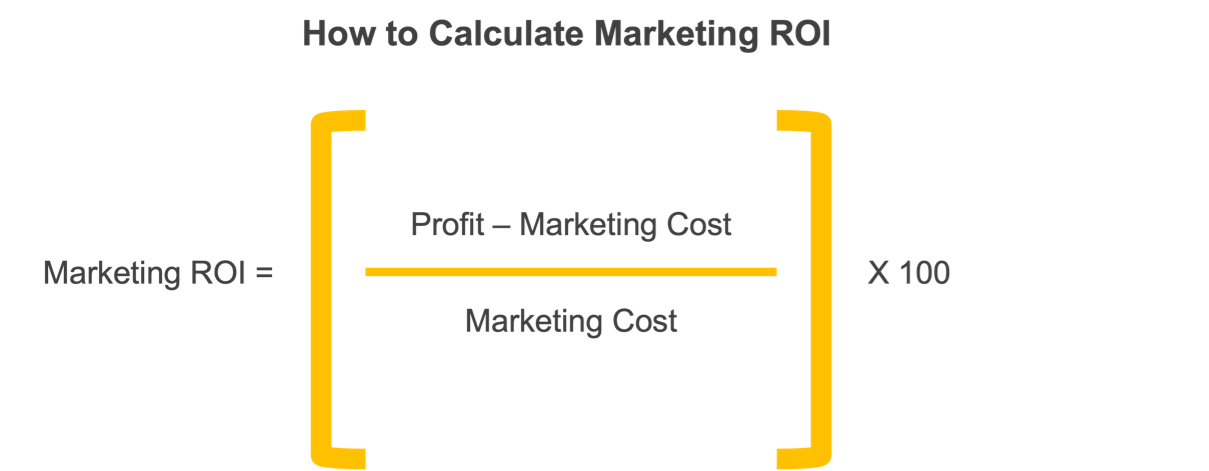With marketing channels multiplying, it can be hard to understand the impact of channel choice and investments on brand equity and sales. Return on marketing investments (ROMI) is an essential metric to measure. It lets you know how effective your marketing activities are and can provide the data to help improve efforts. The challenge is knowing how to do this effectively.
ROI vs ROMI
Before we get into the specifics of ROMI it’s important to differentiate it from return on investment (ROI). ROI is a measure of the monetary value of an investment, any investment. When looking at the ROI meaning in marketing, you are thinking specifically of marketing ROI or ROMI which measures the specific monetary value of marketing investments or campaigns.
How to calculate marketing ROI
A brand’s return on marketing investment is, quite simply, how much money they get back compared to the costs involved. To calculate marketing ROI, you take the sales growth (the profit), subtract marketing costs, and then divide by the marketing costs.

When it comes to ROMI calculation, it’s important to assess the effectiveness of marketing activities in general, and through specific channels. Calculating ROMI allows marketers to:
-
Evaluate marketing campaign performance
ROMI is one of the key performance indicators for marketing efforts. It allows you to evaluate the success (or lack of) for marketing campaigns. - Get a better idea of where to spend money
The return on marketing investment will highlight which channels are doing well, and which may need more – or less – of a focus. Marketers are able to view the channels and campaigns that drive the most profit and direct more attention to these avenues. - Effectively review future marketing budgets
Once you know which channels and campaigns drive the most profit, you can plan future marketing budgets around this. Also, a bigger return on marketing investment may result in leadership allocating more money for future campaigns.
But calculating ROMI is not without its challenges which include:
-
Measuring the right metrics
What are key performance indicators in marketing? What metrics should marketers focus on? - Multiple touchpoints
As well as knowing which metrics to evaluate, it’s also challenging to know which touchpoints to attribute to sales. During a consumer’s path to purchase, they will likely be exposed to, and interact with, multiple touchpoints and so knowing exactly how much value can be allocated to each touchpoint is hard. - Making sense of the data
With many different channels and touchpoints, there can be a mass of data to sort through, not all of it easily comparable. It can be hard to cut through the noise and highlight the key areas of focus.
How to measure return on marketing investments
To tap into the opportunity and overcome the challenges, it’s important for marketers to implement best-practices in measurement. These include:
-
Agree on the metrics you’re tracking
As we’ve seen, measuring ROMI can be a useful way to plan future campaigns and allocate budget. But this is only helpful if the right metrics are being assessed. Focusing on metrics that will add value to your brand and help it grow are the key to justifying marketing spend. - Look at both short-term and long-term goals
A brand’s return on marketing investment often excludes longer-term results. Because of this, focusing solely on your ROMI can create a fallacy of growth that comes at the expense of long-term brand building. So, it’s important for brands to not focus solely on this metric, but instead, to look at it as part of a broader picture in order to plan and track for brand growth. - Understand attribution models
In an environment where marketing channels are multiplying, understanding the impact of channel choices and investments on both brand equity and sales has become an even greater challenge. Without the ability to quickly quantify which channels – or mix of channels – provide desired outcomes, strategic planning and budget allocation lose accuracy. As a result, it's possible to rely too much on measurable marketing channels for decision-making and investment.
One way to tackle these challenges, and to follow best practice around measurement, is to have a comprehensive and easy-to-use marketing analytics software plan in place. Total Marketing ROI, which provides a comprehensive assessment of marketing ROI, measures short and long-term impact of marketing on both sales and brand equity. Our Kantar marketing analytics software allows marketers to better make decision by providing a deeper understanding of the relative contribution of marketing assets, and is globally scalable, delivering consistent outputs across markets and brands.
How to improve your return on marketing investments
Through marketing, brands inevitably want to optimize investments to increase demand. So, how should you do this?
- Set goals – and constantly work towards them
If you want to improve something, you must first set tangible goals – and then make sure your actions are driven by a desire to achieve them. Make goals specific, set deadlines, and – most importantly – make them achievable. - Keep long-term goals in mind
When setting your marketing KPIs, it can be easy to get swept away in the short-term wins, but, as we have seen, this can be detrimental to long-term brand goals. Make sure that overall brand growth is front of mind when setting and implementing your goals and consider how tools such as a marketing KPI dashboard can help maintain transparency of data. - Experiment with A/B testing
The best way to know which channel or method delivers the biggest ROI is to test them out. A/B testing is a simple and effective way to compare campaign strategies and channels. It may feel like you aren’t making any gains in the short-term but figuring out what works best for you brand will help deliver those long-term goals. - Implement the right marketing analytics software and track KPIs
When you’re unsure how to set KPIs for marketing, testing different campaign types is tempting. This strategy will only deliver results if you have the right systems in place to track their progress, though. Making sure you select a platform that helps you gain deeper validation of marketing investment decisions through fast, quantifiable results will inevitably help improve ROMI.
You should now have a better idea of how to calculate marketing ROI, and the best ways to measure and improve your return on investments. The best way to improve ways of working is to get a plan in place and then make good on those plans.
Get in touch to see how Kantar Analytics can help deliver easy, actionable insights.
